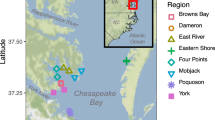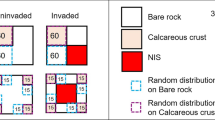Abstract
The macrofaunal colonization of isolated habitats is affected by many factors, ranging from distance to the nearest source population to the dispersal mechanism of the species. We investigated the initial epifaunal colonization at two sites, one situated in the Northern Gulf of Mexico and the other in the Northern Baltic Sea. At each site, artificial seagrass units were placed at 10- and 20-m distances from a continuous seagrass meadow, as well as inside the meadow over a 5-day colonization time. With the exception of amphipods in Gulf of Mexico, patch isolation had a negative effect on colonization for the other faunal species, irrespective of the sites. This inverse colonization pattern of amphipods suggests that they are not equally sensitive to patch isolation in different regions. Our results indicate that increasing habitat isolation can have serious consequences for the community composition of seagrass epifauna. Furthermore, we emphasize the need for larger-scale latitudinal comparative studies.




Similar content being viewed by others
References
Armonies W (1994) Drifting meio- and macrobenthic invertebrates on tidal flats in Königshafen: a review. Helgolander Meeresun 48:299–320
Barnes RSK, Ellwood MDF (2011) Macrobenthic assemblage structure in a cool-temperate intertidal dwarf eelgrass bed in comparison with those from lower latitudes. Biol J Linn Soc 104:527–540
Bell JD, Steffe AS, Westoby M (1985) Artificial seagrass: how useful is it for field experiments on fish and macroinvertebrates. J Exp Mar Biol Ecol 90:171–177
Bologna P, Heck KL (2000) Impacts of seagrass habitat architecture on bivalve settlement. Estuaries 23:449–457
Bonsdorff E, Pearson TH (1999) Variation in the sublittoral macrozoobenthos of the Baltic Sea along environmental gradients: a functional-group approach. Aust J Ecol 24:312–326
Boström C, Bonsdorff E (1997) Community structure and spatial variation of benthic invertebrates associated with Zostera marina (L.) beds in the northern Baltic Sea. J Sea Res 37:153–166
Boström C, Bonsdorff E (2000) Zoobenthic community establishment and habitat complexity—the importance of seagrass shoot-density, morphology and physical disturbance for faunal recruitment. Mar Ecol Prog Ser 205:123–138
Boström C, Mattila J (1999) The relative importance of food and shelter for seagrass-associated invertebrates: a latitudinal comparison of habitat choice by isopod grazers. Oecologia 120:162–170
Boström C, Mattila J (2005) Effects of isopod grazing: an experimental comparison in cold-temperate (Idotea balthica, Baltic Sea, Finland) and subtropical (Erichsonella attenuata, Gulf of Mexico, U.S.A) ecosystems. Crustaceana 78(2):185–200
Boström C, Jackson EL, Simenstad CA (2006) Seagrass landscapes and their effects on associated fauna: a review. Est Coast Shelf Sci 68:383–403
Boström C, Törnroos A, Bonsdorff E (2010) Invertebrate dispersal and habitat heterogeneity: expression of biological traits in a seagrass landscape. J Exp Mar Biol Ecol 390:106–117
Boström C, Pittman SJ, Simenstad C, Kneib RT (2011) Seascape ecology of coastal biogenic habitats: advances, gaps, and challenges. Mar Ecol Prog Ser 427:191–217
Brooks RA, Bell SS (2001) Mobile corridors in marine landscapes: enhancement of faunal exchange at seagrass/sand ecotones. J Exp Mar Biol Ecol 264:67–84
Canion CR, Heck KL Jr (2009) Effect of habitat complexity on predation success: re-evaluating the current paradigm in seagrass beds. Mar Ecol Prog Ser 393:37–43
Clarke KR, Warwick RM (1994) Change in marine communities: an approach to statistical analysis and interpretation. Nat Environ Res Council, UK
Dahl E (1973) Ecological range of Baltic and North Sea species. Oikos Suppl 15:85–90
Duarte CM (2000) Marine biodiversity and ecosystem services: an elusive link. J Exp Mar Biol Ecol 250:117–131
Duffy JE, Richardson JP, Canuel EA (2003) Grazer diversity effects on ecosystem functioning in seagrass beds. Ecol Lett 6:637–645
Edgar GJ (1991) Artificial algae as habitats for mobile epifauna: factors affecting colonization in a Japanese Sargassum bed. Hydrobiologia 226:111–118
Eggleston DB, Elis WE, Etherington LL, Dahlgren CP, Posey MH (1999) Organism responses to habitat fragmentation and diversity: habitat colonization by estuarine macrofauna. J Exp Mar Biol Ecol 236:107–132
Gustafsson C, Boström C (2009) Effects of plant species richness and composition on epifaunal colonization in brackish water angiosperm communities. J Exp Mar Biol Ecol 382:8–17
Healey D, Hovel KA (2004) Seagrass bed patchiness: effects on epifaunal communities in San Diego Bay, USA. J Exp Mar Biol Ecol 313:155–174
Heck KL, Wilson KA (1987) Predation rates on decapods crustaceans in latitudinally separated seagrass communities: a study of spatial ad temporal variation using tethering techniques. J Exp Mar Biol Ecol 53:125–134
Hemminga MA, Duarte CM (2000) Seagrass ecology. Cambridge University Press, Cambridge
Hillebrand H (2004) Strength, slope and variability of marine latitudinal gradients. Mar Ecol Prog Ser 273:251–267
Howard RK (1985) Measurements of short-term turnover of epifauna within seagrass beds using an in situ staining method. Mar Ecol Prog Ser 22:163–168
Irlandi EA (1994) Large- and small-scale effects of habitat structure on rates of predation: how percent coverage of seagrass affects rates of predation and siphon nipping on an infaunal bivalve. Oecologia 98:176–183
Irlandi EA, Ambrose WG, Orlando BA (1995) Landscape ecology and the marine environment: how spatial configuration of seagrass habitat influences growth and survival of the bay scallop. Oikos 72:307–313
Kumagai NH (2006) Distance effects on patterns and processes of dispersal in an octocoral-associated amphipod. Mar Ecol Prog Ser 321:203–214
Leinikki J, Backer H, Oulasvirta P, Leinikki S, Ruuskanen A (2004) Aaltojen alla. Itämeren vedenalaisen luonnon opas. Gummerus Kirjapaino Oy, Jyväskylä (in Finnish)
Lima SL, Dill LM (1990) Behavioral decisions made under the risk of predation: a review and prospectus. Can J Zool 68:619–640
MacArthur RH, Wilson EO (1967) The theory of island biogeography. Princeton University Press, Princeton
Norkko J, Bonsdorff E, Norkko A (2000) Drifting algal mats as an alternative habitat for benthic invertebrates: species specific responses to a transient resource. J Exp Mar Biol Ecol 248:79–104
Orth RJ, Carruthers JB, Dennison WC, Duarte CM, Fourqueran JW, Heck KL, Hughes AR, Kendrick GA, Kenworthy WJ, Olyarnik S, Short FT, Waycott M, Williams SL (2006) A global crisis for seagrass ecosystems. Bioscience 56:987–996
Pearson TH, Rosenberg R (1987) Feast and famine: structuring factors in marine benthic communities. In: Gee JHR, Giller PS (eds) Organization of communities past and present. Blackwell, NJ
Råberg S, Kautsky L (2008) Grazer identity is crucial for facilitating growth of the perennial brown alga Fucus vesiculosus. Mar Ecol Prog Ser 361:111–118
Ribes T, Salvadó H, Romero J, del Pilar Gracia M (2000) Foraminiferan colonization on artificial seagrass leaves. J Foramin Res 3:192–201
Roberts DA, Poore AGB (2005) Habitat configuration affects colonisation of epifauna in a marine algal bed. Biol Conserv 127:18–26
Russell BD, Gillanders BM, Connell SD (2005) Proximity and size of neighbouring habitat affects invertebrate diversity. Mar Ecol Prog Ser 296:31–38
Salovius S, Nyqvist M, Bonsdorff E (2005) Life in the fast lane: macrobenthos use temporary drifting algal habitats. J Sea Res 53:169–180
Sirota L, Hovel KA (2006) Simulated eelgrass Zostera marina structural complexity: effects of shoot length, shoot density, and surface area on the epifaunal community of San Diego Bay, California, USA. Mar Ecol Prog Ser 326:115–131
Sogard SM (1989) Colonization of artificial seagrass by fishes and decapods crustaceans: importance of proximity to natural eelgrass. J Exp Mar Biol Ecol 133:15–37
Sogard SM, Able KW (1994) Diel variation in immigration of fishes and decapods crustaceans to artificial seagrass habitat. Estuaries 17:622–630
Stoner AW, Lewis FG (1985) The influence of quantitative and qualitative aspects of habitat complexity in tropical sea-grass meadows. J Exp Mar Biol Ecol 94:19–40
Tanner J (2005) Edge effects on fauna in fragmented seagrass meadows. Austral Ecol 30:210–218
Upston J, Booth DJ (2003) Settlement and density of juvenile fish assemblages in natural, Zostera capricorni (Zosteraceae) and artificial seagrass beds. Environ Biol Fish 66:91–97
Virnstein RW, Curran MC (1986) Colonization of artificial seagrass versus time and distance from source. Mar Ecol Prog Ser 29:279–288
Virnstein RW, Nelson WG, Lewis FG, Howard RK (1984) Latitudinal patterns in seagrass epifauna: do patterns exist, and can they be explained? Estuaries 7:310–330
Acknowledgments
We thank the Dauphin Island Sea Lab, USA, and Husö Biological Station, Finland, for working facilities. We are grateful to K. Heck, J. Mattila and C. Boström for comments on earlier versions of the manuscript and two anonymous reviewers for their commentary. We also thank K. O’Brien for language revision. K. Heck, J. Mattila, E. Money, M. Ajemian and C. Boström are thanked for their assistance in the field. The study was funded by the Maj and Tor Nessling Foundation (CG). Travels were funded by Åbo Akademi University (TS).
Author information
Authors and Affiliations
Corresponding author
Additional information
Communicated by F. Bulleri.
Rights and permissions
About this article
Cite this article
Gustafsson, C., Salo, T. The effect of patch isolation on epifaunal colonization in two different seagrass ecosystems. Mar Biol 159, 1497–1507 (2012). https://doi.org/10.1007/s00227-012-1932-7
Received:
Accepted:
Published:
Issue Date:
DOI: https://doi.org/10.1007/s00227-012-1932-7




